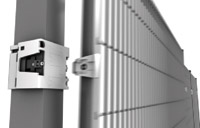
Posted to News on 24th May 2012, 00:00
Compliant machine guarding
Fixed guarding, when properly designed, manufactured and installed, can play an important role in ensuring machinery safety in accordance with the Machinery Directive, as Geoff McBride explains

>When considering 'fixed guards' the Machinery Directive 2006/42/EC is really a vehicle for a number of standards. EN953.1997+A1 2009, deals with the general design characteristics and manufacture of fixed guards. EN ISO 13857.2008 is concerned with safety distances, to prevent upper and lower limbs from entering areas of risk.
>Also included in the directive is EN1088, covering interlocks and the way in which they interact with guarding. This standard is currently being re-written and the new version is expected to come into force in 2013.
>Any machine safety program or procedure must begin with a risk assessment. To comply with the directive this risk assessment must be carried out within the parameters laid down in EN ISO 12100. Any risks identified must be minimised and one of the ways in which this can be achieved, is by introducing 'safeguards', including the fitting of fixed guarding or fencing. The directive states that guarding must:
>
- Be of robust construction.
- Be securely held in place.
- Not give rise to additional hazard.
- Not be easily bypassed or rendered non operational.
- Cause minimum obstruction to the view of the production operation.
- Protect against the ejection or falling of materials or objects and against generated by the machinery.
>A further requirement is that all fixings must be captive, and therefore remain attached either to the guard or machine when a panel is released. Another very important stipulation is that fixing systems must be of a type which can be removed only with specific tools. Where possible, guards must be incapable of staying in place without their fixings, thereby avoiding a situation in which a guard is presumed to be operating safely when in fact unsafe.
>The first issue dealt with in ISO 13857 is that of reaching over protective structures or guards. Here we must consider the height of the hazard, the height of the fence or guard and the distance from guard to hazard. Design and installation of compliant guarding is always a trade off of these three factors. For example, with a hazard 2000mm high and a fence of 2200mm high the horizontal safety distance must be 400mm, as per Table 2 within the standard. Table 4 describes safety distances in consideration of reaching through regular openings. Here we see that an aperture of 50x50mm requires a safety distance, whereas reducing the mesh size to 20x120mm will allow the fence to be situated 120mm from the hazard.
>EN 953 also explores the matter of colours and visibility of hazards. If the guarding is in a neutral grey such as RAL7037 and the hazard in a brighter colour, then the hazard becomes clearly more visible than if the guard and hazard are of a similar shade. En 953.5.10 tells us that where viewing of machine operation is required through the guarding, materials should be selected with suitable properties. Therefore, where steel mesh is used it should be of adequate aperture size (whilst considering Table 4 above) and suitable colour to allow viewing.
>Safety distance calculator tools and further information on compliant machine safety products is available via customer login at the Troax website.






